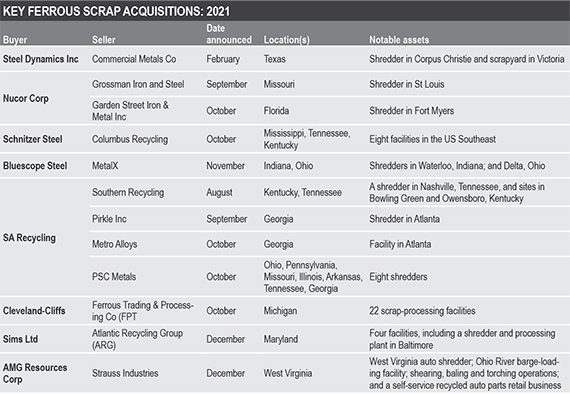A wave of large acquisitions once again changed the industry’s landscape as steel mills assumed control of dominant entities and a new mega-recycler was formed.
With the story still unfolding – and more mergers and acquisitions on the horizon for 2022 – smaller scrap dealers are stunned and wondering how this new wave of acquisitions will play out.
The pent-up demand for finished steel products driven by the fallout of the Covid-19 pandemic revealed a scrap metal shortage and drove up prices for shredded and No1 busheling by $150-200 a ton over the course of 2021.
Ageing patriarchs of family recycling businesses enjoyed strong financials created from the high selling prices and realized this was the ideal time to cash out.
At the same time, mills flush with profits had plenty of cash in hand and quickly scooped up huge companies including shredding operations.
“The industry seems to go through these waves of consolidation every 25 years or so as ageing owners look to cash out. What we’ve seen this year though is consolidation on steroids,” one scrap dealer in Ohio Valley said.
“There’s been a combination of cheap money due to low interest rates, steel mills making money hand over fist and both ferrous and nonferrous scrap prices booming, which typically never happens. But I also don’t think the current wave of consolidation is over just yet.”
For more than a decade, two flat-rolled producers with scrap assets dominated the field but had to move over and make room for a third giant when Cleveland-Cliffs bought FPT Corp for $775 million in October.
Until then, Charlotte, North Carolinas steelmaker Nucor Corp with David J Joseph Company and Ft Wayne Indiana mill Steel Dynamics with OmniSource Corp were the major participants.
The entry of a third large entity is actually a silver lining, according to some recyclers, who think there is more chance for mills to fight for tons with three participants instead of two.
On a smaller scale, Northstar BlueScope bought MetalX in November, which included two shredding locations to become vertically integrated.
Another scrap source said that this did not mean that the smaller operator would go by way of the dinosaur. “As long as steel mills run the yards, there will always be room down the street for a scrap dealer,” he said.
As the domestic industry continues its transformation from blast furnace technology, which relies on iron ore, to scrap-based electric-arc furnace technology, scrap has become a strategic asset.
Shredders have caught the eye of mills, with many sold during the year as mills aggressively work to lock up supply. There is some concern that environmental justice efforts are making it harder and harder to get a shredder permitted, which is playing out in regions such as Chicago and California.
Shredded scrap is also the grade used by all types of steelmaking. During the year, Nucor purchased shredders in Florida and St Louis, Missouri, while Steel Dynamics purchased a Texan shredder.
Other mega-deals are said to be in the works.
“Everyone is for sale right now,” a third scrap source said, noting that the profitable 2021 equates to a larger payday.
In addition to mills locking up supply, a new mega-recycler emerged – with Orange, California-based SA Recycling scooping up every shredder it could get its hands on only to end the year with its purchase of PSC Metals. Its buying spree means that SA will now control more than 400,000 tons per month and own 24 shredding operations.
Sources are divided over the impact of the consolidation, which is reminiscent of 2007-08 when Nucor bought DJJ and Steel Dynamics bought OmniSource.
One Midwest seller source is concerned. “Mills are buying up more big boy scrap yards with surely more to sell out. The scrap guy in the Midwest will never receive the right and true market price for their ferrous feedstock going into melting.”
While some scrap sources are afraid it will be harder to remain relevant, others are quick to point out there are plenty of independent mills in the US with no scrap assets that will still need to be fed.
Another positive is the export market, which the mills have no control over. Whenever the export market heats up and supply is tight, mills find themselves in competition with international buyers for the same pile of scrap.
Whatever the implications for the industry, sources are unanimous that the current wave of consolidation is not over yet.







